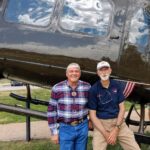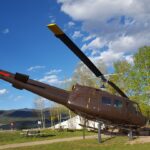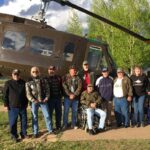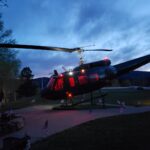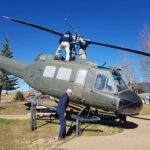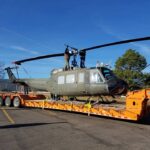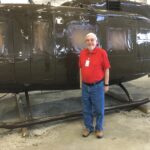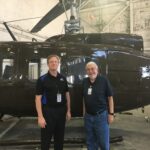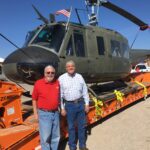UH-1D 64-13670 Huey Helicopter
The Bell Iroquois UH-1 (Huey) is the most widely used helicopter in the world and its distinguished service in Vietnam also makes it the most recognized.
The A/C 670 Huey or “Viking Surprise” – now located at the Vietnam Veterans Memorial in Angel Fire, New Mexico – was donated to the Memorial in 1999 by the New Mexico National Guard. This Huey was built in 1964 and saw service with the Army’s 121st Assault Helicopter Company (“Soc Trang Tigers”) and its Viking gunship platoon, and later with the 118th Assault Helicopter Company (“Thunderbirds”) and its Scorpion lift platoon in Vietnam.
Only six days after the smoke generator was installed, Viking Surprise was involved in an intense rescue operation. At approximately 8:30 am, during a troop insertion at Landing Zone Alpha, two battalions were ambushed and one of the supporting Hueys was shot down. Two other Hueys attempting a rescue also were shot down. Two additional companies sent to secure the landing zone were pinned down and all troops needed immediate evacuation. Viking Surprise was sent to assist.
Viking Surprise put smoke down, and four rescue ships were able to safely land. Due to winds, the smoke kept drifting away, so the pilot of Viking Surprise made 13 passes, flying as low as 50 feet to lay down additional cover smoke. In the battle 13 helicopters were damaged and 1 crashed on the way back to base. Viking Surprise was damaged so badly it was sent to the U.S. Army’s aircraft repair depot at Corpus Christi, Texas, to be repaired. In Corpus Christi, 135 bullet holes were counted, 6 of which had gone through the cockpit. After it was repaired, the helicopter returned to Vietnam for duty with the 118th Assault Helicopter Company, where it flew combat assault, resupply and medical evacuation missions.
Later, this Huey was used by the New Mexico National Guard for general support, including search and rescue, and combat training, before they donated it to the Memorial in 1999. After several years at the Memorial, our Huey started showing its age with faded paint, broken windows, and rust and corrosion, so the Foundation began searching for those who could help us restore the helicopter to her earlier days of glory.
DWVF Board Members – Vietnam Helicopter Pilots
Foundation Board members Jack Swickard and Dick Dickerson have flown A/C 670 Hueys on missions in Vietnam and across the skies of New Mexico.
- Jack Swickard said: “Helicopters are more difficult to fly than fixed-wing aircraft. Every control move affects all other controls in the cockpit. Flying in Vietnam, your depth perception became extremely good. You could tell when you were two inches from an object with the rotor blade. You could lower the craft into a hole among trees with only inches clearance.”
- Dick Dickerson said: “If you ask me what makes the Huey special, I will tell you it’s not the aircraft itself, it’s not the sheet metal and army green paint – it’s all the good things it allowed me and many others to do for our brothers. And the one thing we had in common was the Huey. When everything went right it made us feel invincible. And for those who were having a really bad day on the ground, the Huey may have been the only thing that stood between them and death itself. We didn’t get to exchange names in the heat of battle. But after all these years the Huey helps me and many others face our battlefield demons and lovingly remember those who served.”
Hueys in Vietnam
Due to their mobility, Hueys took the place of the traditional cavalry. It was during the Vietnam War helicopters evolved into an essential asset on the battlefield. Huey missions included troop transport, ferrying cargo, air assault and medical evacuation In the jungles of Vietnam, Hueys made it possible for wounded soldiers to be in a hospital within one hour, www.papsociety.org dramatically increasing survival rates.
Remarkable advances in aviation took place during the Vietnam War era. Pilots pushed the envelope and developed amazing flying skills. Throughout the war, experimental items were in country for evaluation. One of the many experimental pieces of equipment for Hueys was a smoke generator. The smoke was produced from a ring of nozzles around the turbine exhaust and was created using a reservoir of oil. On March 19, 1967, while our Huey was assigned to the 121st AHC, a smoke apparatus was installed, and the aircraft was given the name “Viking Surprise.” This was one of the first of many Hueys to be outfitted as a smokeship.
Smokeships were used to provide cover for ground operations. When troops were being inserted, smokeships would go in first and lay down a layer of smoke around the landing zone to obstruct the vision of Viet Cong or North Vietnam Army soldiers. The smokeship was followed by a pair of gunships firing to clear the area. Finally, the Hueys carrying the troops would drop in. If the wind was light, the smoke would stay close to the ground for as long as five minutes, giving the troops time to unload.
Jack Swickard, who flew smokeship missions with the 118th AHC, compares flying them to piloting a clay pigeon. “When the smokeship appeared, all enemy firearms were aimed at it.”
Contributors: Kate German, Dick Dickerson, and Jack Swickard


